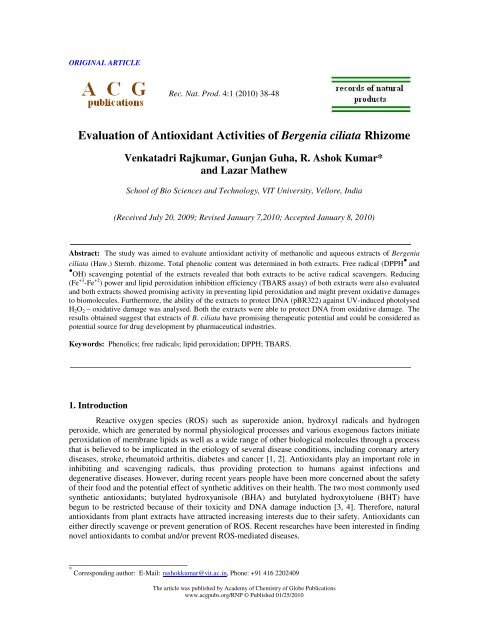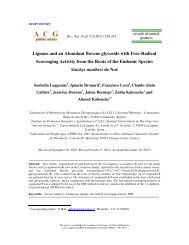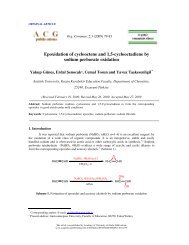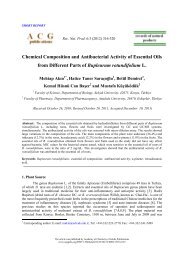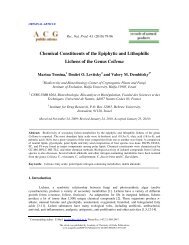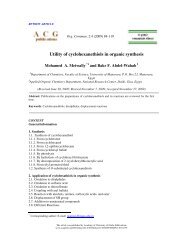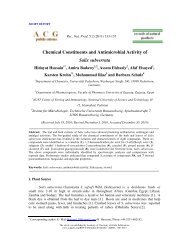Evaluation of Antioxidant Activities of Bergenia ciliata Rhizome
Evaluation of Antioxidant Activities of Bergenia ciliata Rhizome
Evaluation of Antioxidant Activities of Bergenia ciliata Rhizome
Create successful ePaper yourself
Turn your PDF publications into a flip-book with our unique Google optimized e-Paper software.
ORIGINAL ARTICLERec. Nat. Prod. 4:1 (2010) 38-48<strong>Evaluation</strong> <strong>of</strong> <strong>Antioxidant</strong> <strong>Activities</strong> <strong>of</strong> <strong>Bergenia</strong> <strong>ciliata</strong> <strong>Rhizome</strong>Venkatadri Rajkumar, Gunjan Guha, R. Ashok Kumar*and Lazar MathewSchool <strong>of</strong> Bio Sciences and Technology, VIT University, Vellore, India(Received July 20, 2009; Revised January 7,2010; Accepted January 8, 2010)Abstract: The study was aimed to evaluate antioxidant activity <strong>of</strong> methanolic and aqueous extracts <strong>of</strong> <strong>Bergenia</strong><strong>ciliata</strong> (Haw.) Sternb. rhizome. Total phenolic content was determined in both extracts. Free radical (DPPH ● and● OH) scavenging potential <strong>of</strong> the extracts revealed that both extracts to be active radical scavengers. Reducing(Fe +3 -Fe +2 ) power and lipid peroxidation inhibition efficiency (TBARS assay) <strong>of</strong> both extracts were also evaluatedand both extracts showed promising activity in preventing lipid peroxidation and might prevent oxidative damagesto biomolecules. Furthermore, the ability <strong>of</strong> the extracts to protect DNA (pBR322) against UV-induced photolysedH 2 O 2 – oxidative damage was analysed. Both the extracts were able to protect DNA from oxidative damage. Theresults obtained suggest that extracts <strong>of</strong> B. <strong>ciliata</strong> have promising therapeutic potential and could be considered aspotential source for drug development by pharmaceutical industries.Keywords: Phenolics; free radicals; lipid peroxidation; DPPH; TBARS.1. IntroductionReactive oxygen species (ROS) such as superoxide anion, hydroxyl radicals and hydrogenperoxide, which are generated by normal physiological processes and various exogenous factors initiateperoxidation <strong>of</strong> membrane lipids as well as a wide range <strong>of</strong> other biological molecules through a processthat is believed to be implicated in the etiology <strong>of</strong> several disease conditions, including coronary arterydiseases, stroke, rheumatoid arthritis, diabetes and cancer [1, 2]. <strong>Antioxidant</strong>s play an important role ininhibiting and scavenging radicals, thus providing protection to humans against infections anddegenerative diseases. However, during recent years people have been more concerned about the safety<strong>of</strong> their food and the potential effect <strong>of</strong> synthetic additives on their health. The two most commonly usedsynthetic antioxidants; butylated hydroxyanisole (BHA) and butylated hydroxytoluene (BHT) havebegun to be restricted because <strong>of</strong> their toxicity and DNA damage induction [3, 4]. Therefore, naturalantioxidants from plant extracts have attracted increasing interests due to their safety. <strong>Antioxidant</strong>s caneither directly scavenge or prevent generation <strong>of</strong> ROS. Recent researches have been interested in findingnovel antioxidants to combat and/or prevent ROS-mediated diseases.__________________________* Corresponding author: E-Mail: rashokkumar@vit.ac.in, Phone: +91 416 2202409The article was published by Academy <strong>of</strong> Chemistry <strong>of</strong> Globe Publicationswww.acgpubs.org/RNP © Published 01/25/2010
39Rajkumar et al, Rec. Nat. Prod. (2010) 4:1 38-48<strong>Bergenia</strong> <strong>ciliata</strong> (Haw.) Sternb., is commonly called winter bergonia. It is an evergreenperennial herb growing to 0.3 m by 0.5 m. B. <strong>ciliata</strong> rhizome extracts is proved to have anti-bacterialand anti-tussive properties [5, 6]. It is reported to be helpful in dissolving kidney stones [7]. B. <strong>ciliata</strong> isused in traditional ayurvedic medicine for the treatment <strong>of</strong> several diseases in Nepal, India, Pakistan,Bhutan and some other countries. Thus the aim <strong>of</strong> the present study was to evaluate antioxidantproperties <strong>of</strong> methanolic and aqueous extracts <strong>of</strong> B. <strong>ciliata</strong> rhizomes by measuring scavenging activityagainst free radicals, reducing capacity and protection <strong>of</strong> biological molecules from reactive oxygenspecies-induced damage.2. Materials and Methods2.1 Chemicals1, 1-diphenyl-2-picrylhydrazyl (DPPH), thiobarbituric acid (TBA), gallic acid, ascorbic acid,trichloroacetic acid (TCA) was purchased from Himedia Laboratories Pvt. Ltd. (India). Folin-Ciocalteaureagent was procured from Sisco Research Lab (India), and pBR322 was purchased from MedoxBiotech India Pvt. Ltd. (India). The remaining chemicals and solvents used were <strong>of</strong> standard analyticalgrade and HPLC grade, respectively.2.2 Plant materialB. <strong>ciliata</strong> rhizomes were collected from their natural habitat in the Himalayas at Rudraprayag(30º28’ N, 78º98’ E), Uttaranchal, India. The specimens were identified by C. Sathyanarayanan, AryaVaidya Pharmacy (Coimbatore) Limited, Kanjikode, Palakkad, India. Collected specimens were shadedried, powdered, sieved and stored until further use. Voucher specimens were maintained in laboratoryfor future reference (Herbarium # VIT/SBCBE/CCL/07/6/07; Dated: June 11, 2007).2.3 Extraction50 g <strong>of</strong> B. <strong>ciliata</strong> rhizome powder was serially extracted with using methanol and water assolvents in a Soxhlet apparatus. The powder:solvent ratio was maintained as 1:6. The extracts obtainedwere evaporated to dryness at 40 °C in reduced pressure (methanol: 337 mbar and Aqueous: 72 mbar) ina rotary evaporator (BUCHI, Switzerland). The dried extracts were weighed to determine the yield <strong>of</strong>soluble constituents and stored in a vacuum desiccator.2.4 Determination <strong>of</strong> Total Phenolic CompoundsTotal phenolic content was determined by the method described by Lister and Wilson (2001)[8]. 50 µg, 100 µg, 150 µg, 200 µg and 250 µg <strong>of</strong> the extracts were made up to 0.5 mL with distilledwater. 2.5 mL <strong>of</strong> Folin-Ciocalteau reagent (1:10 dilution) and 2 mL <strong>of</strong> sodium carbonate (7.5% w/v)were added and the tubes incubated at 45 ºC for 15 min. The absorbance was read at 765 nm using aCary 50 UV-Vis spectrophotometer (Varian, Inc., CA, USA). Gallic acid was used as a standard, andresults were expressed in terms <strong>of</strong> gallic acid equivalence (GAE) in µg.2.5 Reducing powerThe ability <strong>of</strong> the extracts to reduce Fe +3 – Fe +2 was accessed by the method <strong>of</strong> Yildirim et al.(2001) [9]. 50 µg, 100 µg, 150 µg, 200 µg and 250 µg <strong>of</strong> the extracts were mixed with 2.5 mL <strong>of</strong> 0.2 Mphosphate buffer (pH 6.6; 1.79% NaH 2 PO 4 and 1.89% Na 2 HPO 4 ) and 2.5 mL <strong>of</strong> 1% potassiumferricyanide. The mixture was incubated at 50 ºC for 30 min. 2.5 mL <strong>of</strong> 10% trichloroacetic acid was
<strong>Antioxidant</strong> activities <strong>of</strong> <strong>Bergenia</strong> <strong>ciliata</strong> rhizome 40later added and the tubes were centrifuged at 3000 rpm for 10 min. 2.5 mL <strong>of</strong> the upper layer solutionwas mixed with 2.5 mL <strong>of</strong> distilled water and 0.5 mL <strong>of</strong> 0.1% ferric chloride added. Absorbance wasmeasured at 700 nm. Increasing absorbance values <strong>of</strong> the reaction mixture indicated increasing reducingpower <strong>of</strong> the extracts.2.6 DPPH Radical Scavenging AssayFree radical scavenging ability <strong>of</strong> the extracts was tested by DPPH radical scavenging assay asdescribed by Blois (1958) [10]. 20 µg, 40 µg, 60 µg, 80 µg and 100 µg <strong>of</strong> the extracts were taken in testtubes and made up to 0.5 mL with the respective solvents. 3 mL <strong>of</strong> 0.1 mM DPPH ● in ethanol wasadded to each tube and incubated in dark at room temperature for 30 min. The absorbance was read at517 nm using a Cary 50 UV-Vis Spectrophotometer (Varian Inc., Australia). The percentage inhibition(I %) was calculated using the formula,2.7 Thiobarbituric Acid Reactive Assay (TBARS)I % = [Abs (Control) - Abs (Sample)] / Abs (Control) x 100.The assay was performed as described by Halliwell and Gutteridge (1999) [11], in which theextent <strong>of</strong> lipid peroxidation was estimated from the concentration <strong>of</strong> malondialdehyde (MDA), athiobarbituric acid reactive substance (TBARS), which is produced due to lipid peroxidation. The liverfor the preparation <strong>of</strong> homogenate to be used in this assay was obtained from Wistar strain Albino ratsafter approval <strong>of</strong> the Institutional Animal Ethical Committee (PSGIMSR/27.02.2008) and wasperformed in accordance to the “Principles <strong>of</strong> Laboratory Animal Care” (NIH publication #85-23,revised in 1985) (NIH, 1985) [12].50 µg, 100 µg, 150 µg, 200 µg and 250 µg <strong>of</strong> the extracts were taken in test tubes and wereevaporated to dryness at 80 ºC. 1 mL <strong>of</strong> 0.15 M potassium chloride was added to the tubes followed by0.5 mL <strong>of</strong> rat liver homogenate (10% w/v in PBS; calcium, magnesium free). Peroxidation was initiatedby the addition <strong>of</strong> 100 µl <strong>of</strong> 2 mM ferric chloride. After incubating the tubes for 30 min at 37 ºC, theperoxidation reaction was stopped by adding 2 mL <strong>of</strong> ice-cold HCl (0.25 N) containing 15% TCA and0.38% TBA. The tubes were kept at 80 ºC for 1 hour, cooled and centrifuged at 7500 rpm. Theabsorbance <strong>of</strong> the supernatant, containing TBA-MDA complex was read at 532 nm. The anti-lipidperoxidation activity (ALP %) was calculated using the formula,ALP % = [Abs (Control) - Abs (Sample)] / Abs (Control) x 1002.8 Hydroxyl radical scavenging activity● OH radical scavenging activities <strong>of</strong> the extracts were estimated by the method <strong>of</strong> Klein et al.(1981) [13]. 50 µg, 100 µg, 150 µg and 200 µg <strong>of</strong> the extracts were taken in test tubes. 1 mL <strong>of</strong> iron-EDTA solution (0.13% ferrous ammonium sulfate and 0.26% EDTA), 0.5 mL <strong>of</strong> 0.018% EDTA and 1mL <strong>of</strong> 0.85% (v/v) DMSO (in 0.1 M phosphate buffer, pH 7.4) were added followed by 0.5 mL <strong>of</strong>0.22% (w/v) ascorbic acid. The tubes were capped tightly and incubated on a water bath at 85 ºC for 15min. Post incubation, the test tubes were uncapped and ice-cold trichloroacetic acid (17.5% w/v) wasadded in each immediately. 3 mL <strong>of</strong> Nash reagent (7.5 g <strong>of</strong> ammonium acetate, 300 µl glacial acetic acidand 200 µl acetyl acetone were mixed and made up to 100 mL with distilled water) was added to all thetubes and incubated at room temperature for 15 min. Absorbance was measured at 412 nm. Percentagehydroxyl radical scavenging activity (HRSA %) was calculated by the following formula:HRSA % = [(Abs (control) – Abs (Sample)/Abs (Control)] x 100
41Rajkumar et al, Rec. Nat. Prod. (2010) 4:1 38-482.9 DNA damage inhibition efficiencyPotential DNA damage inhibition by B. <strong>ciliata</strong> extracts was tested by photolysing H 2 O 2 by UVradiation in presence <strong>of</strong> pBR322 plasmid DNA and performing agarose gel electrophoresis with theirradiated DNA [14]. 1 µl aliquots <strong>of</strong> pBR322 (200 µg/mL) were taken in three polyethylenemicrocentrifuge tubes. 50 µg <strong>of</strong> each extract was separately added to two tubes. The remaining tube wasleft untreated as the irradiated control (C R ). 4 µl <strong>of</strong> 3% H 2 O 2 was added to all the tubes which were thenplaced directly on the surface <strong>of</strong> a UV transilluminator (300 nm). The samples were irradiated for 10min at room temperature. After irradiation, 4 µl <strong>of</strong> tracking dye (0.25% bromophenol blue, 0.25%xylene cyanol FF and 30% glycerol) was added. The samples in all tubes were then analyzed by gelelectrophoresis on a 1% agarose gel in TBE buffer (pH 8). Untreated non-irradiated pBR322 plasmid(C) was run along with the extract-treated UV-irradiated samples (methanolic extract treated = S M andaqueous extract treated = S A ) and untreated UV-irradiated (C R ) plasmid DNA. The gel was stained inethidium bromide (1 µg/mL; 30 min) and photographed on Lourmat Gel Imaging System (Vilbar,France).2.10 Statistical analysisAll data were recorded as mean ± standard deviation <strong>of</strong> triplicate measurements. Thesignificance <strong>of</strong> differences among treatment means was determined by one-way ANOVA. MATLABver. 7.0 (Natick, MA, USA) and Micros<strong>of</strong>t Excel 2007 (Roselle, IL, USA) were used for the statisticaland graphical evaluations.3. Results and Discussion3.1 Extract yield and total phenolics50 g <strong>of</strong> rhizome powder yielded 13.44 g <strong>of</strong> crude methanolic extract and 3.24 g <strong>of</strong> crudeaqueous extract. Phenolic compounds are considered to contribute to the antioxidant activities <strong>of</strong> theplant extracts [15]. Total phenolic contents in the methanolic and aqueous extracts were expressed asGAE and are presented in Table 1. The methanolic extract had higher phenolic content than aqueousextract. This may be due to the difference in the polarity <strong>of</strong> the two solvents, and thereby the differentphenolic components differentially eluted [16].Table 1. Total phenolic contents <strong>of</strong> methanolic and aqueous extracts <strong>of</strong> <strong>Bergenia</strong> <strong>ciliata</strong> rhizomeGAE ± SD (in µg) aAmount (µg) Methanolic Extract Aqueous Extract50100150200250a GAE ± SD at 95% confidence interval19.89 ± 0.32 7.46 ± 0.0433.51 ± 0.34 9.70 ± 0.0948.00 ± 1.01 11.89 ± 0.0259.59 ± 1.38 14.19 ± 0.1361.44 ± 0.09 14.78 ± 0.08
<strong>Antioxidant</strong> activities <strong>of</strong> <strong>Bergenia</strong> <strong>ciliata</strong> rhizome 423.2 Reducing powerReducing capacity <strong>of</strong> the extract components may serve as a significant indicator <strong>of</strong> its potentialantioxidant activity [17]. Different studies have indicated that the electron donation capacity <strong>of</strong> bioactivecompounds is associated with antioxidant activity [18, 19]. Phenolic compounds are reported to be themajor phytochemicals in plants responsible for antioxidant activity <strong>of</strong> plant materials [20]. Figure 1shows the reducing activity <strong>of</strong> both extracts compared with BHT. Reducing power <strong>of</strong> both extractsincreased with an increase in concentration. Methanolic extract displayed a higher reducing activitycompared to the aqueous extract, and its activity at 150 µg was close to that <strong>of</strong> BHT at the sameconcentration.Figure 1. Reducing power <strong>of</strong> methanolic and aqueous extracts <strong>of</strong> B. <strong>ciliata</strong> rhizome. BHT was taken asthe standard.3.3 DPPH radical scavenging assayTo obtain information about the mechanisms <strong>of</strong> the antioxidative effects <strong>of</strong> the extracts, weexamined their radical scavenging effects by measuring changes in absorbance <strong>of</strong> DPPH ● radical at 517nm. Both extracts showed a concentration dependent scavenging <strong>of</strong> DPPH ● radicals. Methanolic extractwas found to be more active radical scavenger than aqueous extract, thus confirming a previous report[21]. The rests <strong>of</strong> DPPH ● radical scavenging assay revealed that the extracts might prevent reactiveradical species from damaging biomolecules such as lipoproteins, polyunsaturated fatty acids (PUFA),DNA, amino acids, proteins and sugars in susceptible biological and food systems [22]. The activity wascompared to ascorbic acid which is employed as the standard, and results were plotted against ascorbicacid equivalence (AAE) in µg (Figure 2).
43Rajkumar et al, Rec. Nat. Prod. (2010) 4:1 38-48Figure 2. DPPH ● scavenging activities <strong>of</strong> methanolic and aqueous extracts <strong>of</strong> B. <strong>ciliata</strong> rhizome withAAE (ascorbic acid equivalence) in µg. Data expressed as mean ± SD <strong>of</strong> n = 3 samples (P
<strong>Antioxidant</strong> activities <strong>of</strong> <strong>Bergenia</strong> <strong>ciliata</strong> rhizome 44Figure 3. <strong>Antioxidant</strong> potential <strong>of</strong> B. <strong>ciliata</strong> rhizome. Data expressed as mean ± SD (n = 3, P
45Rajkumar et al, Rec. Nat. Prod. (2010) 4:1 38-48Figure 4. Relationship between total phenolic content <strong>of</strong> methanolic and aqueous extracts <strong>of</strong> B. <strong>ciliata</strong>rhizomeand (A) DPPH ● radical scavenging potential (I %). (B) Lipid peroxidation inhibition and (C) ● OHscavenging potential. All parameters show strong and significant positive correlation with total phenolic content(at P
3.6 DNA damage inhibition efficiency<strong>Antioxidant</strong> activities <strong>of</strong> <strong>Bergenia</strong> <strong>ciliata</strong> rhizome 46<strong>Antioxidant</strong>s are found to play important role in protecting DNA from various ROS mediateddamages and may be useful in the treatment <strong>of</strong> human diseases where oxygen free-radical production isparticularly implicated. Extracts from medicinal plants are reported for DNA protection and theirprotective nature is attributed to the presence <strong>of</strong> antioxidant components [26].Figure 6 shows the electrophoretic pattern <strong>of</strong> pBR322 DNA following UV-photolysis <strong>of</strong> H 2 O 2 inabsence (in controls C and C R ) and presence (in samples S M and S A ) <strong>of</strong> the extracts. Normal pBR322 (C)showed two bands on agarose gel electrophoresis. The faster moving band represented the native form<strong>of</strong> supercoiled circular DNA (SC DNA) and the slower moving band corresponded to the open circularform (OC DNA) [14]. Both methanolic and aqueous extracts were able to protect DNA to a certainextent. The aqueous extract displayed considerably better protective activity in comparison to themethanolic extract. UV-photolysis <strong>of</strong> H 2 O 2 in C R damaged the entire DNA (no bands visible). While S Ashowed a SC DNA band, though faint in comparison to C, S M didn’t show any band for SC DNA.Instead, it developed a new intermediate band for linear DNA (LIN DNA). The results infer that UVphotolysedH 2 O 2 (3%) treatment <strong>of</strong> pBR322 obliterated the entire DNA (in C R ), while 50 µg <strong>of</strong> both themethanolic and aqueous extracts gave partial protection against DNA damage, with latter having higherprotective potential.Figure 6. Effect <strong>of</strong> methanolic and aqueous extracts <strong>of</strong> B. <strong>ciliata</strong> rhizome at 50 µg concentration on the protection<strong>of</strong> DNA against ● OH radicals generated by photolysis <strong>of</strong> H 2 O 2 . Lane 1: untreated DNA (control); lane 2: 3% H 2 O 2 ;lane 3: Aqueous extract + H 2 O 2 ; lane 4: Methanolic extract + H 2 O 2 . OC = open circular DNA; LIN = linear DNA;SC = supercoiled DNA. Lanes 2, 3 and 4 contained UV-irradiated samples.4. ConclusionMethanolic and aqueous B. <strong>ciliata</strong> rhizome extracts were found to possess antioxidant activity,including reducing power, free radical scavenging activity and lipid peroxidation inhibition potential.The methanolic extract displayed greater potential in all antioxidant assays. It is, however, interesting tonote that the aqueous extract demonstrated considerably higher DNA protection, albeit lagging behindits methanolic counterpart as an antioxidant. B. <strong>ciliata</strong> rhizome extracts might find use in pharmaceuticalindustry as precursors <strong>of</strong> therapeutic drugs that can be implemented as antithesis against oxidative stressand consequent toxicity to cellular biomolecules. Further studies for isolation and identification <strong>of</strong> activecomponents are in prospect.
47Rajkumar et al, Rec. Nat. Prod. (2010) 4:1 38-48AcknowledgementThe authors gratefully acknowledge Mr. C. Sathyanarayanan, Arya Vaidya Pharmacy(Coimbatore) Ltd., Kanjikode, Palakkad, India for his active support. The authors also thank themanagement <strong>of</strong> VIT University, Vellore for providing the necessary facilities for this research.References:[1] B. Halliwell, J.M.C. Gutteridge and C.E. Cross (1992). Free radicals, antioxidants and human disease:where are we now? J Lab Clin Med. 119, 598-620.[2] D.J. Lefer and D.N. Grander (2000). Oxidative stress and cardiac disease. Am J Med. 109, 315-323.[3] N. Ito, M. Hiroze, G. Fukushima, H. Tauda, T. Shira and M. Tatematsu (1986). Studies on antioxidant;their carcinogenic and modifying effects on chemical carcinogensis. Food Chem Toxicol. 24, 1071-1081.[4] Y.F. Sasaki, S. Kawaguchi, A. Kamaya, M. Ohshita, K. Kabasawa, K. Iwama, K. Taniguchi and S. Tsuda(2002). The comet assay with 8 mouse organs: results with 39 currently used food additives. Mutat Res-Gen Tox En. 519, 103-119.[5] S. Sinha, T. Murugesan, K. Maiti, J.R. Gayen, B. Pal, M. Pal and B.P. Saha (2001). Antibacterial activity<strong>of</strong> <strong>Bergenia</strong> <strong>ciliata</strong> rhizome. Fitoterapia 72(5), 550-552.[6] S. Sinha, T. Murugesan, M. Pal and B.P Saha (2001). <strong>Evaluation</strong> <strong>of</strong> anti-tussive activity <strong>of</strong> <strong>Bergenia</strong><strong>ciliata</strong> Sternb. rhizome extract in mice. Phytomedicine 8(4), 298-301.[7] M. Islam, I. Azhar, U. Khan, M. Aslam, A. Ahmad and Shahbuddin (2002). Bioactivity evaluation <strong>of</strong><strong>Bergenia</strong> <strong>ciliata</strong>. Pak J Pharm Sci. 15(1), 15-33.[8] E. Lister and P. Wilson (2001). Measurement <strong>of</strong> total phenolics and ABTS assay for antioxidant activity(personal communication). Crop Research Institute, Lincoln, New Zealand.[9] A. Yildirim, A. Mavi and A.A. Kara (2001). Determination <strong>of</strong> antioxidant and antimicrobial activities <strong>of</strong>Rumes crispus L. extracts. J Agr. Food Chem. 49, 4083-4089.[10] M.S. Blois (1958). <strong>Antioxidant</strong> determinations by the use <strong>of</strong> stable free radical. Nature 81, 1199-2000.[11] B. Halliwell and J.M.C. Gutteridge (1999). Free radicals in biology and medicine. 3 rd edition, OxfordUniversity Press, Oxford, UK.[12] NIH (1985). Principles <strong>of</strong> laboratory care. NIH publication 85-23, NIH, Bethesda, MD.[13] S.M. Klein, G. Cohen and A.I. Cederbaum (1981). Production <strong>of</strong> formaldehyde during metabolism <strong>of</strong>dimethyl sulphoxide by hydroxyl radical generating system. Biochem. 20, 6006-6012.[14] A. Russo, A.A Izzo, V. Cardile, F. Borrelli and A. Vanella (2001). Indian medicinal plants as antiradicalsand DNA cleavage protector. Phytomedicine 8 (2), 125-132.[15] Y.S. Velioglu, G. Mazza, L. Gao and B.P. Oomah (1998). <strong>Antioxidant</strong> activity and total polyphenolics inselected fruits, vegetables, and grain products. J Agr Food Chem. 46, 4113-4117.[16] Y. Choi, H.S. Jeong and J. Lee (2007). <strong>Antioxidant</strong> activity <strong>of</strong> methanolic extracts from some grainsconsumed in Korea. Food chem. 103, 130-138.[17] S. Meir, J. Kanner, B. Akiri and S.P. Hadas (1995). Determination and involvement <strong>of</strong> aqueous reducingcompounds in oxidative defense systems <strong>of</strong> various senescing leaves. J Agr Food Chem. 43, 1813-1815.[18] P. Siddhuraju, P.S. Mohan and K. Becker (2002). Studies on the antioxidant activity <strong>of</strong> Indian Laburnum(Cassia fistula L.): a preliminary assessment <strong>of</strong> crude extracts from stem bark, leaves, flowers and fruitpulp. Food Chem. 79, 61-67.[19] G.C. Yen, P.D. Duh and C.L. Tsai (1993). Relationship between antioxidant activity and maturity <strong>of</strong>peanut hulls. J Agr Food Chem. 41, 67-70.[20] J. Javanmardi, C. Stushn<strong>of</strong>f, E. Locke and J.M. Vivanco (2003). <strong>Antioxidant</strong> activity and total phenoliccontent <strong>of</strong> Iranian Ocimum accessions. Food Chem. 83, 547-550.[21] M.S Bagul, M.N Ravishankara, H. Padh and M. Rajani, (2003). Phytochemical evaluation and free radicalscavenging properties <strong>of</strong> rhizome <strong>of</strong> <strong>Bergenia</strong> <strong>ciliata</strong> (Haw) Sternb. J Nat Rem. 3, 83-89.[22] B. Halliwell, R. Aeschbach, J. Loliger and O.I. Aruoma (1995). The characterization <strong>of</strong> antioxidants.Food Chem Toxicol. 33, 601-617.[23] L.J. Marnett (1999). Lipid peroxidation-DNA damage by malondialdehyde. Mutat Res. 424, 83-95.[24] P. Hochestein and A.S. Atallah (1988). The nature <strong>of</strong> oxidant and antioxidant systems in the inhibition <strong>of</strong>mutation and cancer. Mutat Res. 202, 363-375.
<strong>Antioxidant</strong> activities <strong>of</strong> <strong>Bergenia</strong> <strong>ciliata</strong> rhizome 48[25] H. Kappus (1991). Lipid peroxidation – Mechanism and biological relevance. In O. I. Aruoma and B.Halliwell (Eds.), Free radicals and food additives (pp. 59-75). London, UK: Taylor and Francis.[26] G. Attaguile, A. Russo, A. Campisi, F. Savoca, R. Acquaviva, N. Ragusa and A. Vanella, (2000).<strong>Antioxidant</strong> activity and protective effect on DNA cleavage <strong>of</strong> extracts from Cistus incanus L. and Cistusmonspeliensis L. Cell Biol Toxicol. 16, 83-90.© 2010 Reproduction is free for scientific studies


